Analyzing Friedman's Statement on Business Social Responsibility
VerifiedAdded on 2021/02/20
|8
|1902
|376
Essay
AI Summary
This essay critically examines the assertion that a business's primary social responsibility is to maximize profit, as proposed by Friedman (1970). It delves into various aspects of corporate social responsibility (CSR), including stakeholder theory, the triple bottom line model (economic, environmental, and social sustainability), and practical CSR models like Carroll's pyramid and the EFQM excellence model. The report highlights the importance of ethical business practices, sustainability audits, and stakeholder engagement. It also discusses the skills needed for ethical evaluation. The essay concludes that while profit is essential, long-term success and a competitive advantage require businesses to incorporate sustainability and ethical considerations into their core strategies, as neglecting social responsibility can hinder growth and international expansion.
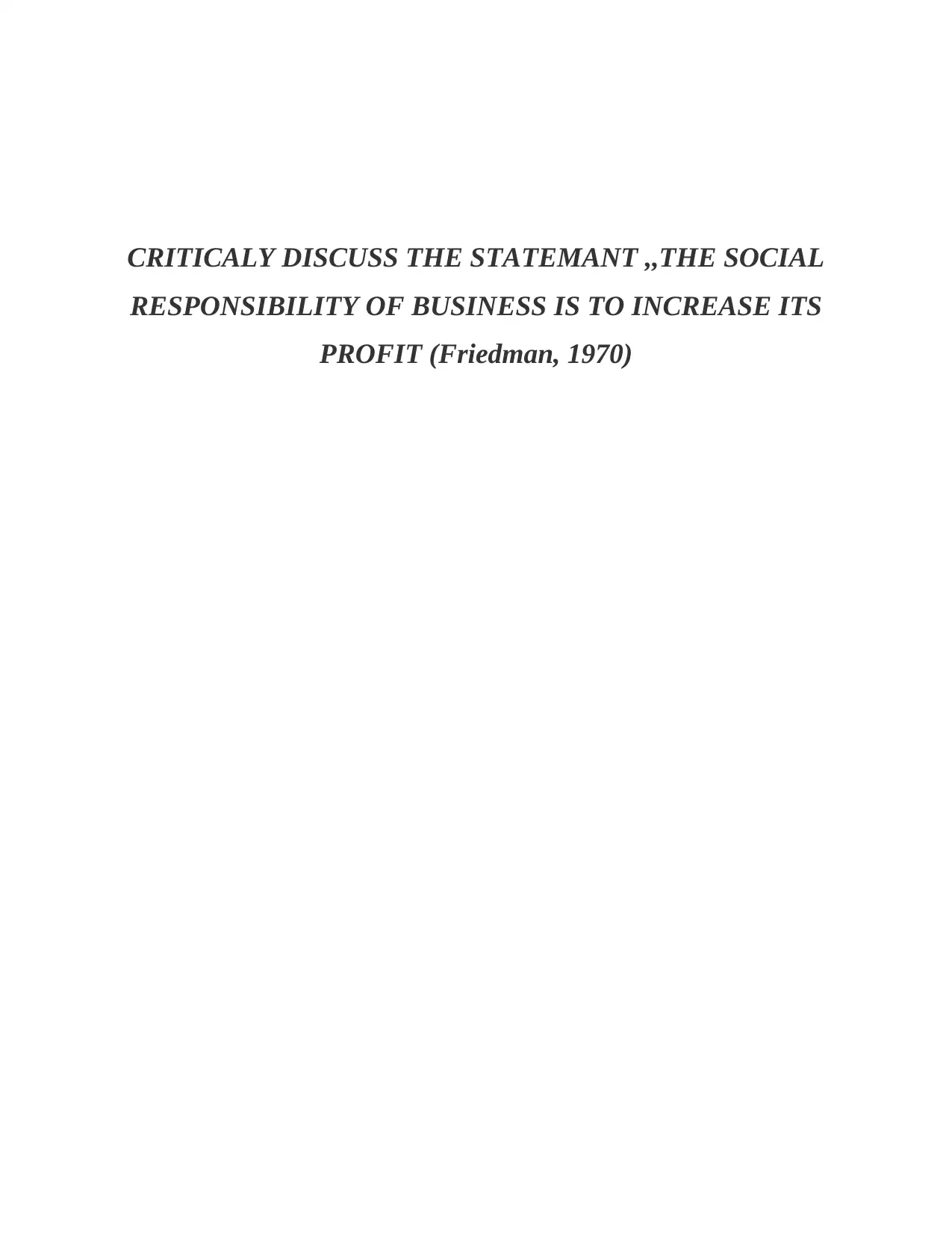
CRITICALY DISCUSS THE STATEMANT ,,THE SOCIAL
RESPONSIBILITY OF BUSINESS IS TO INCREASE ITS
PROFIT (Friedman, 1970)
RESPONSIBILITY OF BUSINESS IS TO INCREASE ITS
PROFIT (Friedman, 1970)
Paraphrase This Document
Need a fresh take? Get an instant paraphrase of this document with our AI Paraphraser
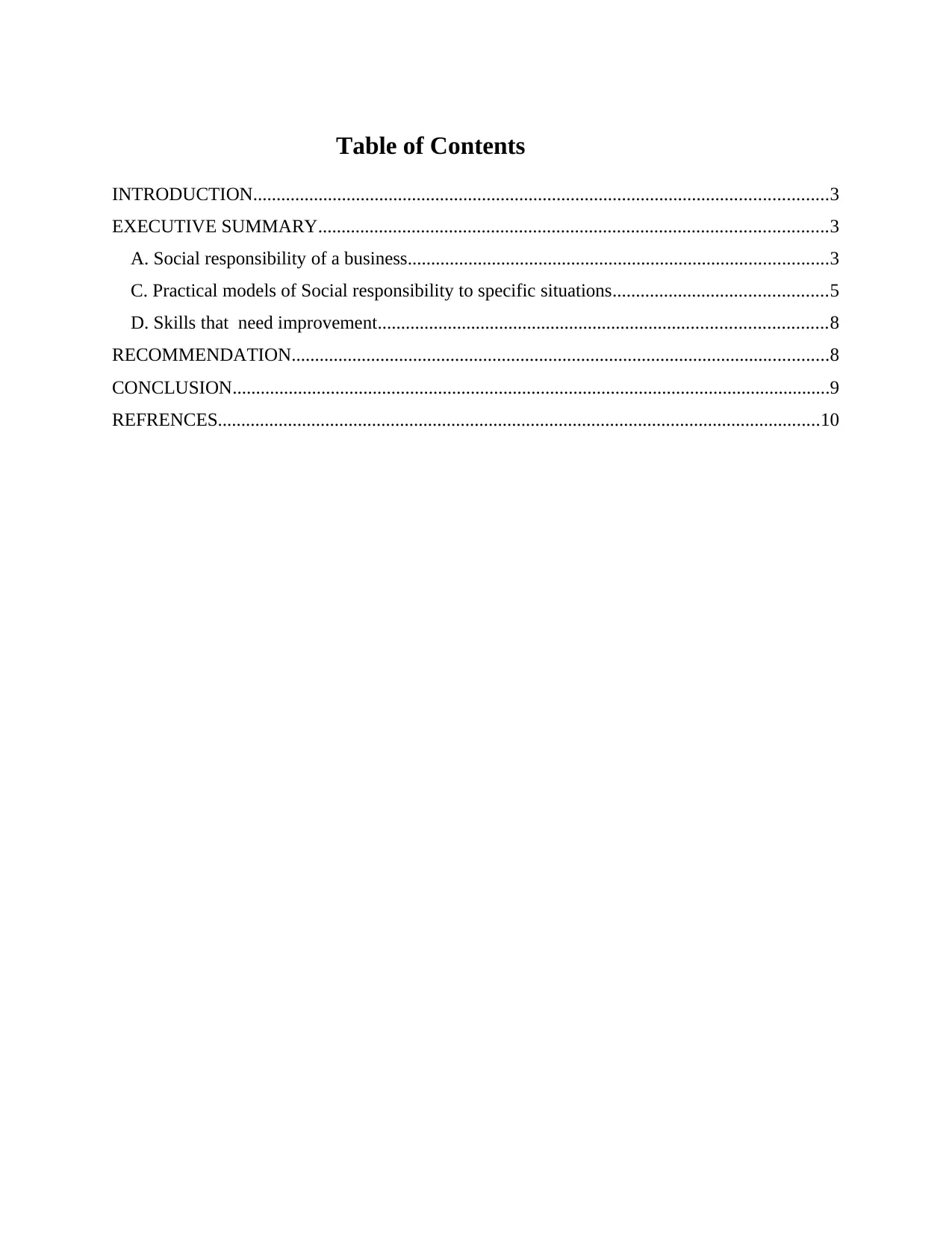
Table of Contents
INTRODUCTION...........................................................................................................................3
EXECUTIVE SUMMARY.............................................................................................................3
A. Social responsibility of a business..........................................................................................3
C. Practical models of Social responsibility to specific situations..............................................5
D. Skills that need improvement................................................................................................8
RECOMMENDATION...................................................................................................................8
CONCLUSION................................................................................................................................9
REFRENCES.................................................................................................................................10
INTRODUCTION...........................................................................................................................3
EXECUTIVE SUMMARY.............................................................................................................3
A. Social responsibility of a business..........................................................................................3
C. Practical models of Social responsibility to specific situations..............................................5
D. Skills that need improvement................................................................................................8
RECOMMENDATION...................................................................................................................8
CONCLUSION................................................................................................................................9
REFRENCES.................................................................................................................................10
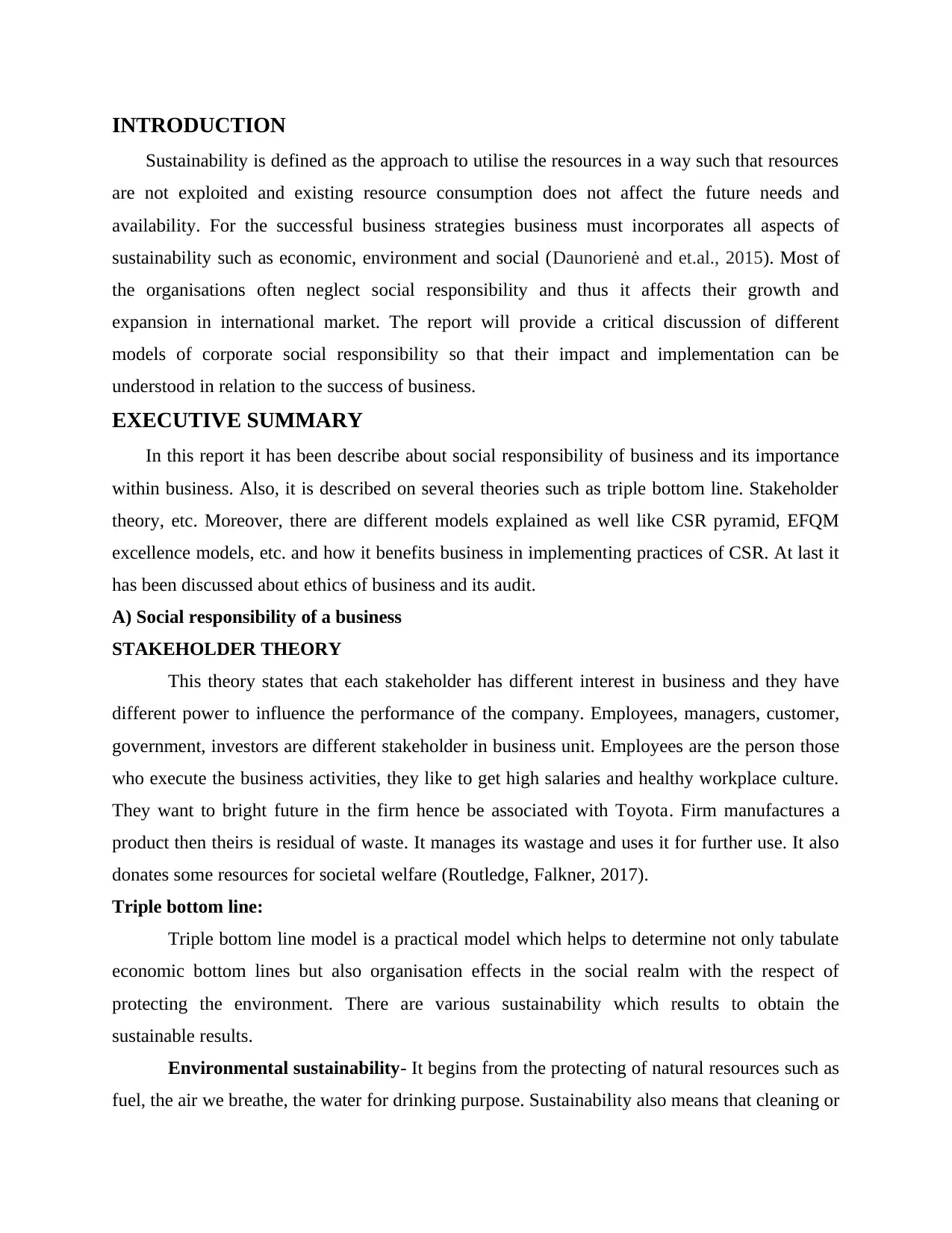
INTRODUCTION
Sustainability is defined as the approach to utilise the resources in a way such that resources
are not exploited and existing resource consumption does not affect the future needs and
availability. For the successful business strategies business must incorporates all aspects of
sustainability such as economic, environment and social (Daunorienė and et.al., 2015). Most of
the organisations often neglect social responsibility and thus it affects their growth and
expansion in international market. The report will provide a critical discussion of different
models of corporate social responsibility so that their impact and implementation can be
understood in relation to the success of business.
EXECUTIVE SUMMARY
In this report it has been describe about social responsibility of business and its importance
within business. Also, it is described on several theories such as triple bottom line. Stakeholder
theory, etc. Moreover, there are different models explained as well like CSR pyramid, EFQM
excellence models, etc. and how it benefits business in implementing practices of CSR. At last it
has been discussed about ethics of business and its audit.
A) Social responsibility of a business
STAKEHOLDER THEORY
This theory states that each stakeholder has different interest in business and they have
different power to influence the performance of the company. Employees, managers, customer,
government, investors are different stakeholder in business unit. Employees are the person those
who execute the business activities, they like to get high salaries and healthy workplace culture.
They want to bright future in the firm hence be associated with Toyota. Firm manufactures a
product then theirs is residual of waste. It manages its wastage and uses it for further use. It also
donates some resources for societal welfare (Routledge, Falkner, 2017).
Triple bottom line:
Triple bottom line model is a practical model which helps to determine not only tabulate
economic bottom lines but also organisation effects in the social realm with the respect of
protecting the environment. There are various sustainability which results to obtain the
sustainable results.
Environmental sustainability- It begins from the protecting of natural resources such as
fuel, the air we breathe, the water for drinking purpose. Sustainability also means that cleaning or
Sustainability is defined as the approach to utilise the resources in a way such that resources
are not exploited and existing resource consumption does not affect the future needs and
availability. For the successful business strategies business must incorporates all aspects of
sustainability such as economic, environment and social (Daunorienė and et.al., 2015). Most of
the organisations often neglect social responsibility and thus it affects their growth and
expansion in international market. The report will provide a critical discussion of different
models of corporate social responsibility so that their impact and implementation can be
understood in relation to the success of business.
EXECUTIVE SUMMARY
In this report it has been describe about social responsibility of business and its importance
within business. Also, it is described on several theories such as triple bottom line. Stakeholder
theory, etc. Moreover, there are different models explained as well like CSR pyramid, EFQM
excellence models, etc. and how it benefits business in implementing practices of CSR. At last it
has been discussed about ethics of business and its audit.
A) Social responsibility of a business
STAKEHOLDER THEORY
This theory states that each stakeholder has different interest in business and they have
different power to influence the performance of the company. Employees, managers, customer,
government, investors are different stakeholder in business unit. Employees are the person those
who execute the business activities, they like to get high salaries and healthy workplace culture.
They want to bright future in the firm hence be associated with Toyota. Firm manufactures a
product then theirs is residual of waste. It manages its wastage and uses it for further use. It also
donates some resources for societal welfare (Routledge, Falkner, 2017).
Triple bottom line:
Triple bottom line model is a practical model which helps to determine not only tabulate
economic bottom lines but also organisation effects in the social realm with the respect of
protecting the environment. There are various sustainability which results to obtain the
sustainable results.
Environmental sustainability- It begins from the protecting of natural resources such as
fuel, the air we breathe, the water for drinking purpose. Sustainability also means that cleaning or
⊘ This is a preview!⊘
Do you want full access?
Subscribe today to unlock all pages.

Trusted by 1+ million students worldwide
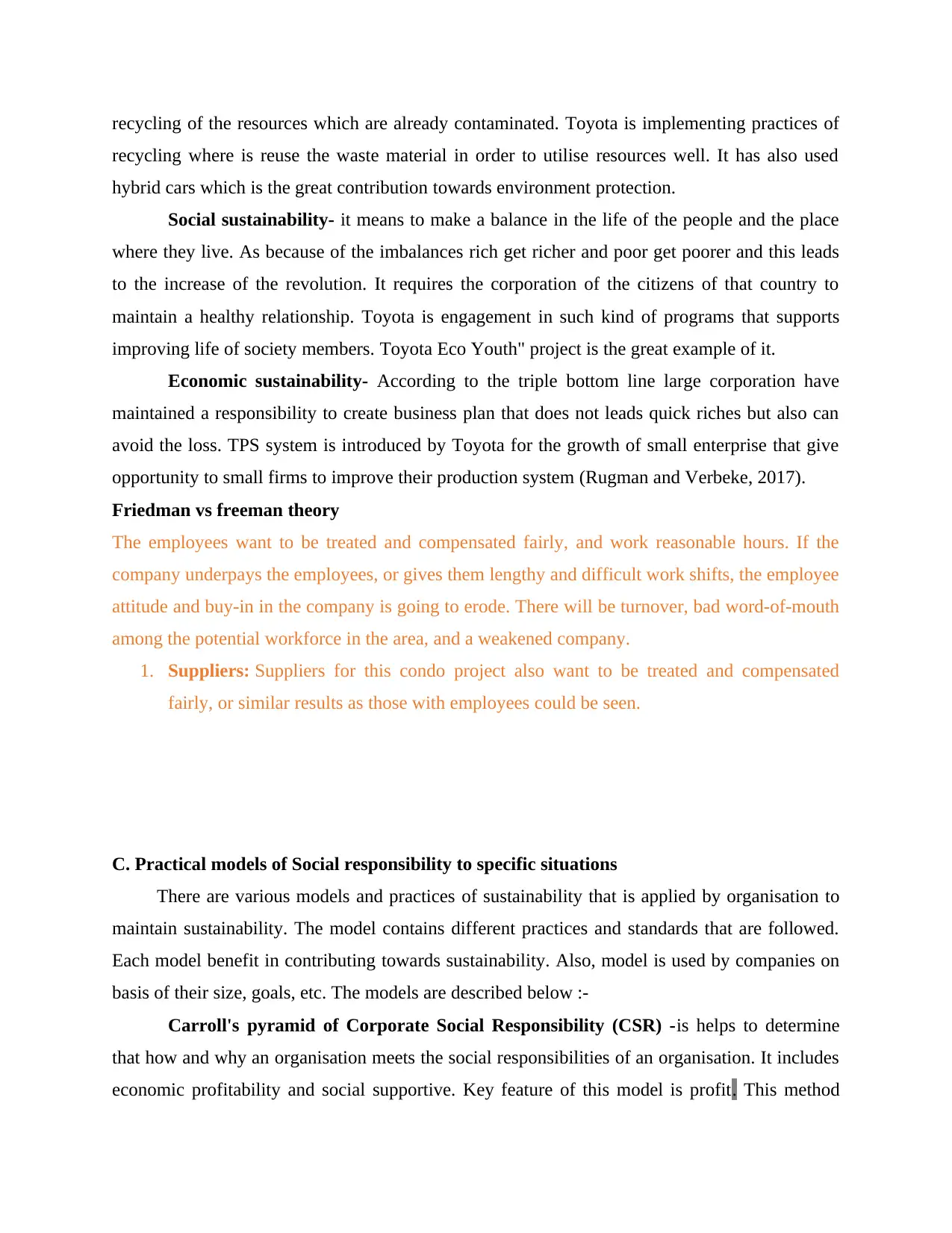
recycling of the resources which are already contaminated. Toyota is implementing practices of
recycling where is reuse the waste material in order to utilise resources well. It has also used
hybrid cars which is the great contribution towards environment protection.
Social sustainability- it means to make a balance in the life of the people and the place
where they live. As because of the imbalances rich get richer and poor get poorer and this leads
to the increase of the revolution. It requires the corporation of the citizens of that country to
maintain a healthy relationship. Toyota is engagement in such kind of programs that supports
improving life of society members. Toyota Eco Youth" project is the great example of it.
Economic sustainability- According to the triple bottom line large corporation have
maintained a responsibility to create business plan that does not leads quick riches but also can
avoid the loss. TPS system is introduced by Toyota for the growth of small enterprise that give
opportunity to small firms to improve their production system (Rugman and Verbeke, 2017).
Friedman vs freeman theory
The employees want to be treated and compensated fairly, and work reasonable hours. If the
company underpays the employees, or gives them lengthy and difficult work shifts, the employee
attitude and buy-in in the company is going to erode. There will be turnover, bad word-of-mouth
among the potential workforce in the area, and a weakened company.
1. Suppliers: Suppliers for this condo project also want to be treated and compensated
fairly, or similar results as those with employees could be seen.
C. Practical models of Social responsibility to specific situations
There are various models and practices of sustainability that is applied by organisation to
maintain sustainability. The model contains different practices and standards that are followed.
Each model benefit in contributing towards sustainability. Also, model is used by companies on
basis of their size, goals, etc. The models are described below :-
Carroll's pyramid of Corporate Social Responsibility (CSR) -is helps to determine
that how and why an organisation meets the social responsibilities of an organisation. It includes
economic profitability and social supportive. Key feature of this model is profit. This method
recycling where is reuse the waste material in order to utilise resources well. It has also used
hybrid cars which is the great contribution towards environment protection.
Social sustainability- it means to make a balance in the life of the people and the place
where they live. As because of the imbalances rich get richer and poor get poorer and this leads
to the increase of the revolution. It requires the corporation of the citizens of that country to
maintain a healthy relationship. Toyota is engagement in such kind of programs that supports
improving life of society members. Toyota Eco Youth" project is the great example of it.
Economic sustainability- According to the triple bottom line large corporation have
maintained a responsibility to create business plan that does not leads quick riches but also can
avoid the loss. TPS system is introduced by Toyota for the growth of small enterprise that give
opportunity to small firms to improve their production system (Rugman and Verbeke, 2017).
Friedman vs freeman theory
The employees want to be treated and compensated fairly, and work reasonable hours. If the
company underpays the employees, or gives them lengthy and difficult work shifts, the employee
attitude and buy-in in the company is going to erode. There will be turnover, bad word-of-mouth
among the potential workforce in the area, and a weakened company.
1. Suppliers: Suppliers for this condo project also want to be treated and compensated
fairly, or similar results as those with employees could be seen.
C. Practical models of Social responsibility to specific situations
There are various models and practices of sustainability that is applied by organisation to
maintain sustainability. The model contains different practices and standards that are followed.
Each model benefit in contributing towards sustainability. Also, model is used by companies on
basis of their size, goals, etc. The models are described below :-
Carroll's pyramid of Corporate Social Responsibility (CSR) -is helps to determine
that how and why an organisation meets the social responsibilities of an organisation. It includes
economic profitability and social supportive. Key feature of this model is profit. This method
Paraphrase This Document
Need a fresh take? Get an instant paraphrase of this document with our AI Paraphraser
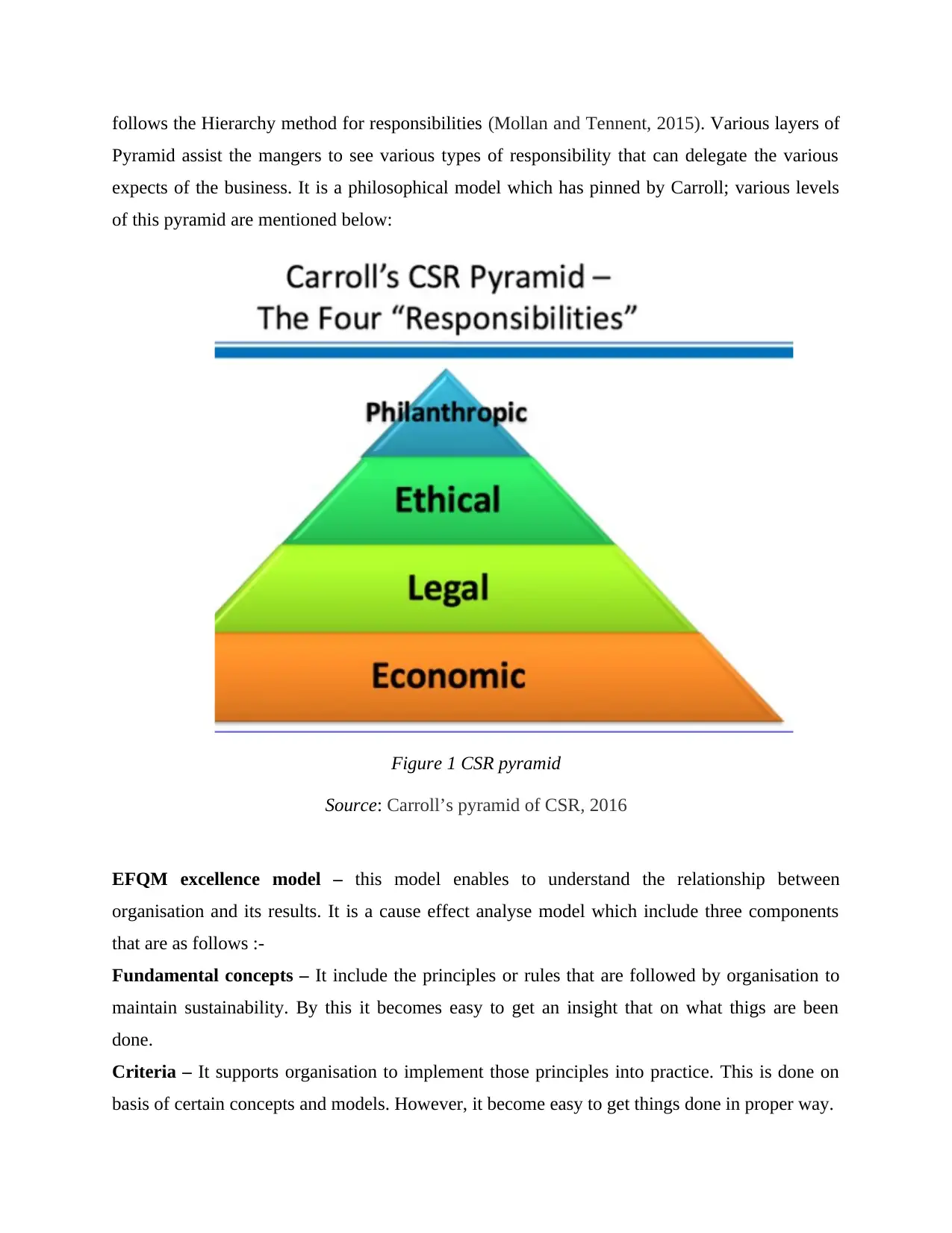
follows the Hierarchy method for responsibilities (Mollan and Tennent, 2015). Various layers of
Pyramid assist the mangers to see various types of responsibility that can delegate the various
expects of the business. It is a philosophical model which has pinned by Carroll; various levels
of this pyramid are mentioned below:
Figure 1 CSR pyramid
Source: Carroll’s pyramid of CSR, 2016
EFQM excellence model – this model enables to understand the relationship between
organisation and its results. It is a cause effect analyse model which include three components
that are as follows :-
Fundamental concepts – It include the principles or rules that are followed by organisation to
maintain sustainability. By this it becomes easy to get an insight that on what thigs are been
done.
Criteria – It supports organisation to implement those principles into practice. This is done on
basis of certain concepts and models. However, it become easy to get things done in proper way.
Pyramid assist the mangers to see various types of responsibility that can delegate the various
expects of the business. It is a philosophical model which has pinned by Carroll; various levels
of this pyramid are mentioned below:
Figure 1 CSR pyramid
Source: Carroll’s pyramid of CSR, 2016
EFQM excellence model – this model enables to understand the relationship between
organisation and its results. It is a cause effect analyse model which include three components
that are as follows :-
Fundamental concepts – It include the principles or rules that are followed by organisation to
maintain sustainability. By this it becomes easy to get an insight that on what thigs are been
done.
Criteria – It supports organisation to implement those principles into practice. This is done on
basis of certain concepts and models. However, it become easy to get things done in proper way.
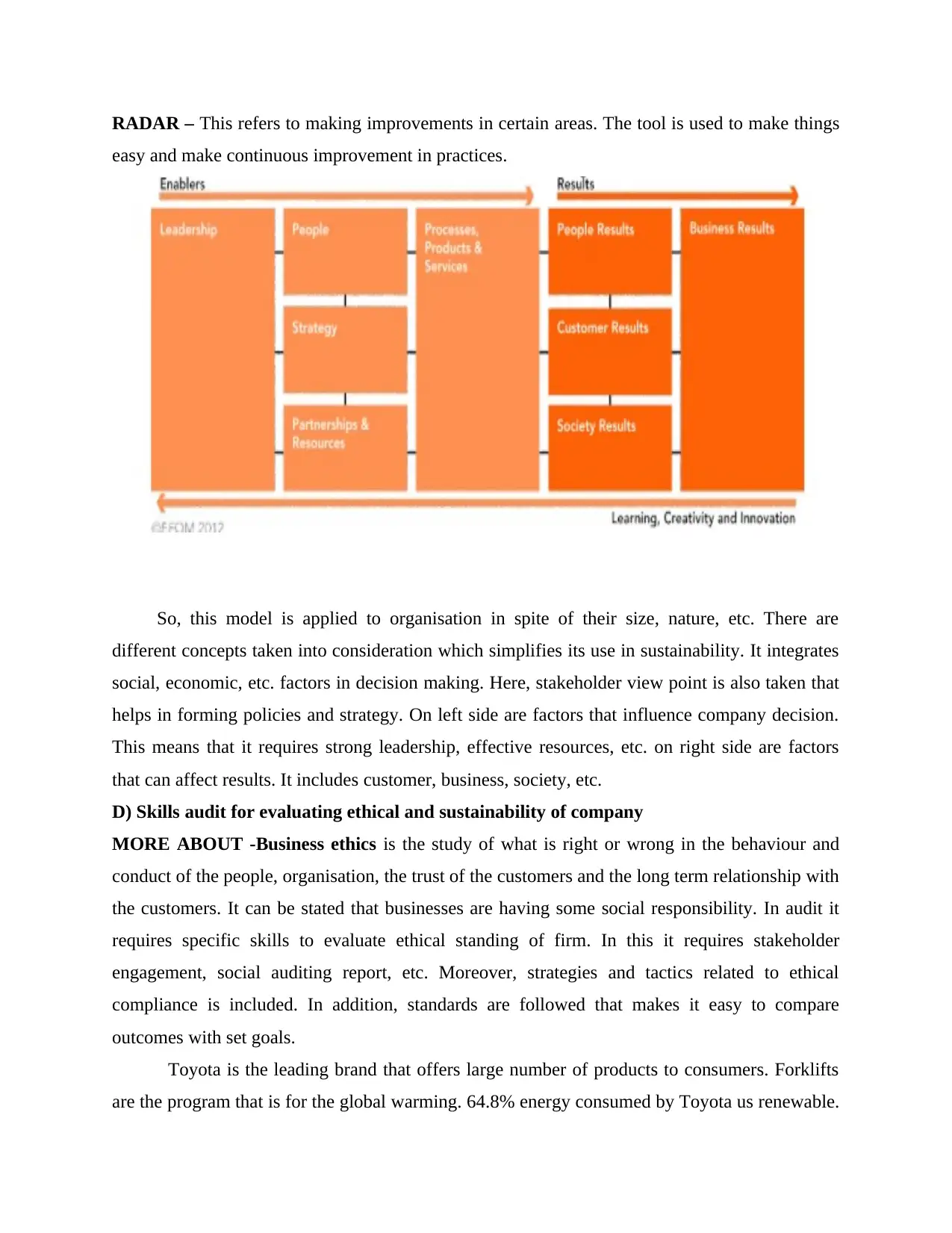
RADAR – This refers to making improvements in certain areas. The tool is used to make things
easy and make continuous improvement in practices.
So, this model is applied to organisation in spite of their size, nature, etc. There are
different concepts taken into consideration which simplifies its use in sustainability. It integrates
social, economic, etc. factors in decision making. Here, stakeholder view point is also taken that
helps in forming policies and strategy. On left side are factors that influence company decision.
This means that it requires strong leadership, effective resources, etc. on right side are factors
that can affect results. It includes customer, business, society, etc.
D) Skills audit for evaluating ethical and sustainability of company
MORE ABOUT -Business ethics is the study of what is right or wrong in the behaviour and
conduct of the people, organisation, the trust of the customers and the long term relationship with
the customers. It can be stated that businesses are having some social responsibility. In audit it
requires specific skills to evaluate ethical standing of firm. In this it requires stakeholder
engagement, social auditing report, etc. Moreover, strategies and tactics related to ethical
compliance is included. In addition, standards are followed that makes it easy to compare
outcomes with set goals.
Toyota is the leading brand that offers large number of products to consumers. Forklifts
are the program that is for the global warming. 64.8% energy consumed by Toyota us renewable.
easy and make continuous improvement in practices.
So, this model is applied to organisation in spite of their size, nature, etc. There are
different concepts taken into consideration which simplifies its use in sustainability. It integrates
social, economic, etc. factors in decision making. Here, stakeholder view point is also taken that
helps in forming policies and strategy. On left side are factors that influence company decision.
This means that it requires strong leadership, effective resources, etc. on right side are factors
that can affect results. It includes customer, business, society, etc.
D) Skills audit for evaluating ethical and sustainability of company
MORE ABOUT -Business ethics is the study of what is right or wrong in the behaviour and
conduct of the people, organisation, the trust of the customers and the long term relationship with
the customers. It can be stated that businesses are having some social responsibility. In audit it
requires specific skills to evaluate ethical standing of firm. In this it requires stakeholder
engagement, social auditing report, etc. Moreover, strategies and tactics related to ethical
compliance is included. In addition, standards are followed that makes it easy to compare
outcomes with set goals.
Toyota is the leading brand that offers large number of products to consumers. Forklifts
are the program that is for the global warming. 64.8% energy consumed by Toyota us renewable.
⊘ This is a preview!⊘
Do you want full access?
Subscribe today to unlock all pages.

Trusted by 1+ million students worldwide
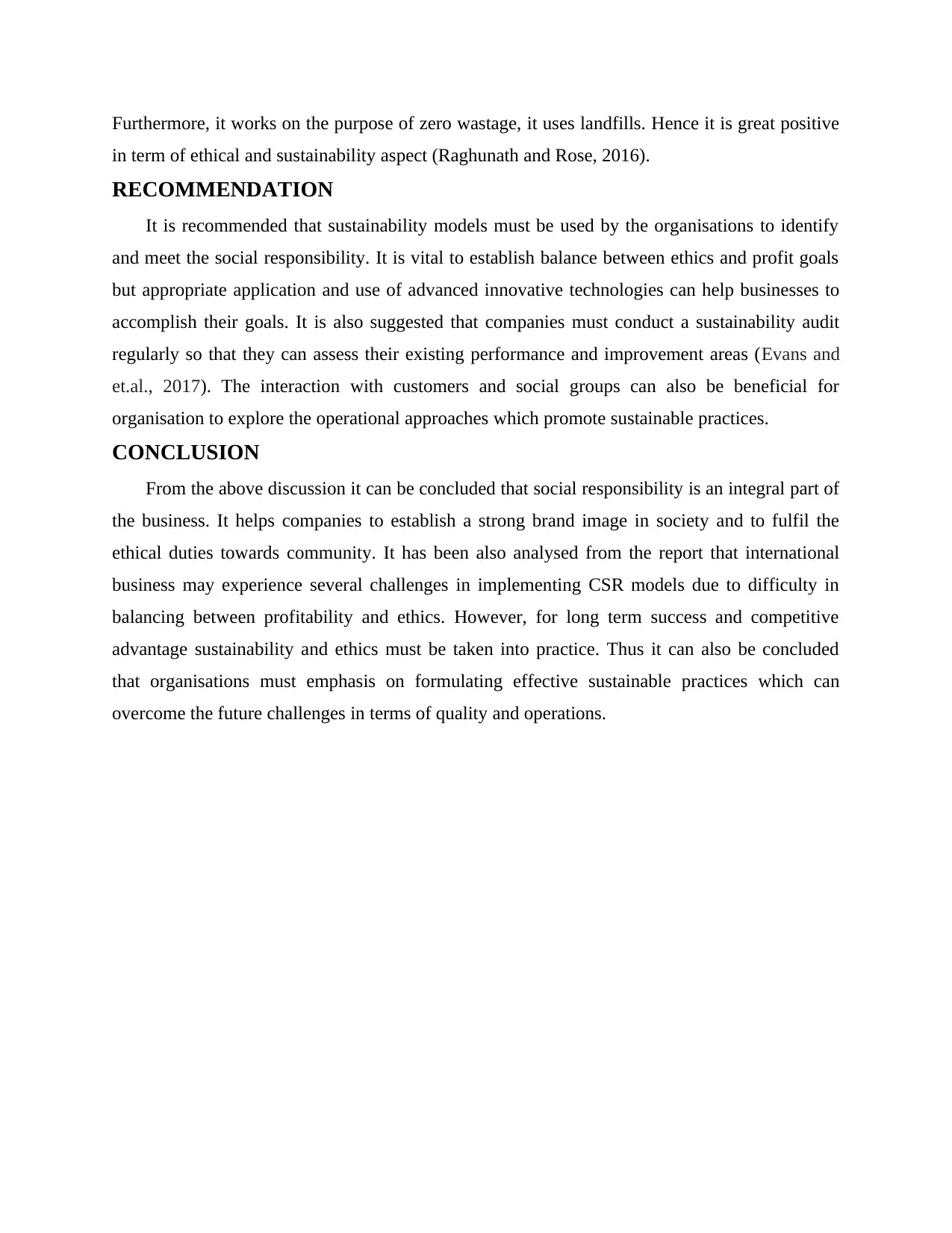
Furthermore, it works on the purpose of zero wastage, it uses landfills. Hence it is great positive
in term of ethical and sustainability aspect (Raghunath and Rose, 2016).
RECOMMENDATION
It is recommended that sustainability models must be used by the organisations to identify
and meet the social responsibility. It is vital to establish balance between ethics and profit goals
but appropriate application and use of advanced innovative technologies can help businesses to
accomplish their goals. It is also suggested that companies must conduct a sustainability audit
regularly so that they can assess their existing performance and improvement areas (Evans and
et.al., 2017). The interaction with customers and social groups can also be beneficial for
organisation to explore the operational approaches which promote sustainable practices.
CONCLUSION
From the above discussion it can be concluded that social responsibility is an integral part of
the business. It helps companies to establish a strong brand image in society and to fulfil the
ethical duties towards community. It has been also analysed from the report that international
business may experience several challenges in implementing CSR models due to difficulty in
balancing between profitability and ethics. However, for long term success and competitive
advantage sustainability and ethics must be taken into practice. Thus it can also be concluded
that organisations must emphasis on formulating effective sustainable practices which can
overcome the future challenges in terms of quality and operations.
in term of ethical and sustainability aspect (Raghunath and Rose, 2016).
RECOMMENDATION
It is recommended that sustainability models must be used by the organisations to identify
and meet the social responsibility. It is vital to establish balance between ethics and profit goals
but appropriate application and use of advanced innovative technologies can help businesses to
accomplish their goals. It is also suggested that companies must conduct a sustainability audit
regularly so that they can assess their existing performance and improvement areas (Evans and
et.al., 2017). The interaction with customers and social groups can also be beneficial for
organisation to explore the operational approaches which promote sustainable practices.
CONCLUSION
From the above discussion it can be concluded that social responsibility is an integral part of
the business. It helps companies to establish a strong brand image in society and to fulfil the
ethical duties towards community. It has been also analysed from the report that international
business may experience several challenges in implementing CSR models due to difficulty in
balancing between profitability and ethics. However, for long term success and competitive
advantage sustainability and ethics must be taken into practice. Thus it can also be concluded
that organisations must emphasis on formulating effective sustainable practices which can
overcome the future challenges in terms of quality and operations.
Paraphrase This Document
Need a fresh take? Get an instant paraphrase of this document with our AI Paraphraser
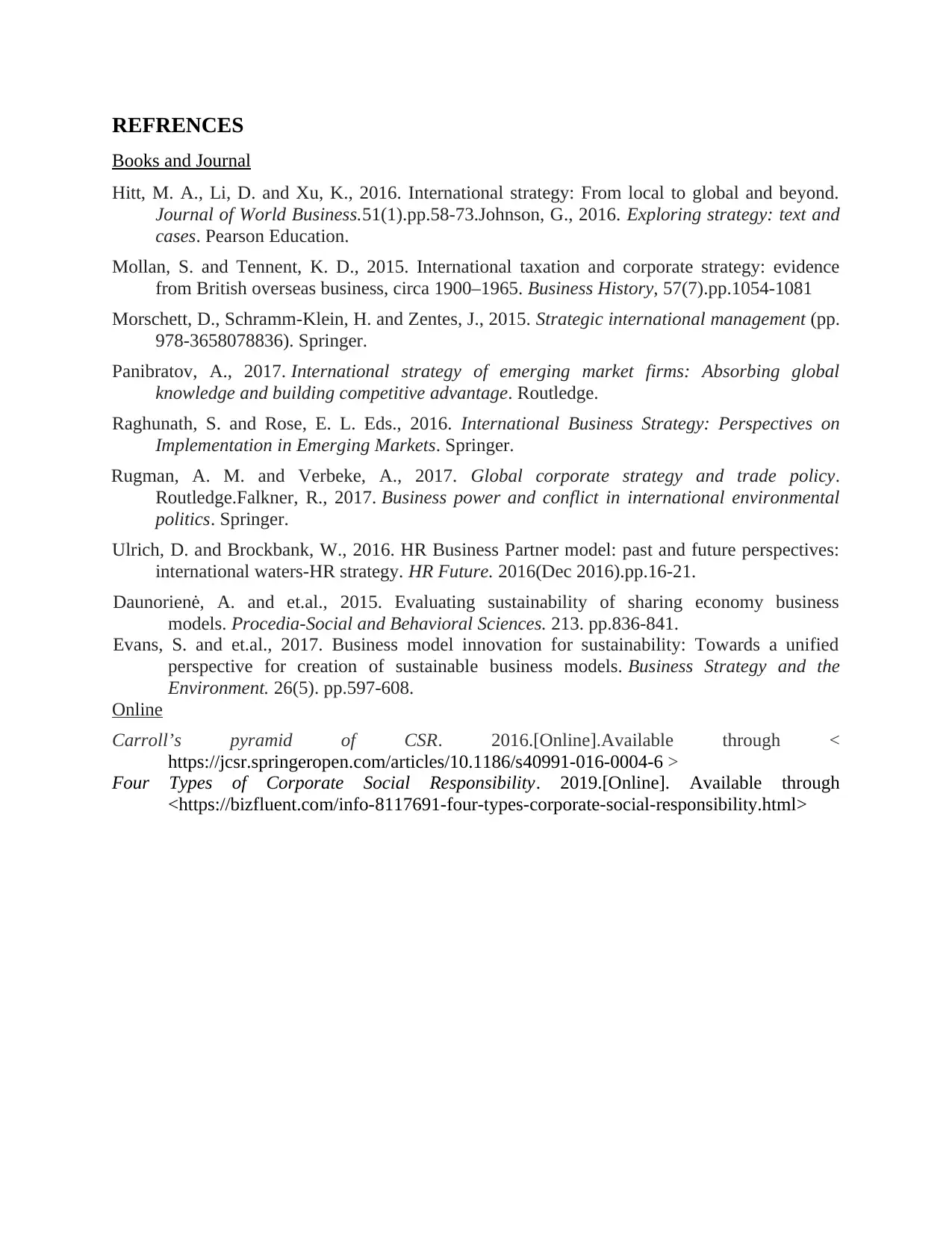
REFRENCES
Books and Journal
Hitt, M. A., Li, D. and Xu, K., 2016. International strategy: From local to global and beyond.
Journal of World Business.51(1).pp.58-73.Johnson, G., 2016. Exploring strategy: text and
cases. Pearson Education.
Mollan, S. and Tennent, K. D., 2015. International taxation and corporate strategy: evidence
from British overseas business, circa 1900–1965. Business History, 57(7).pp.1054-1081
Morschett, D., Schramm-Klein, H. and Zentes, J., 2015. Strategic international management (pp.
978-3658078836). Springer.
Panibratov, A., 2017. International strategy of emerging market firms: Absorbing global
knowledge and building competitive advantage. Routledge.
Raghunath, S. and Rose, E. L. Eds., 2016. International Business Strategy: Perspectives on
Implementation in Emerging Markets. Springer.
Rugman, A. M. and Verbeke, A., 2017. Global corporate strategy and trade policy.
Routledge.Falkner, R., 2017. Business power and conflict in international environmental
politics. Springer.
Ulrich, D. and Brockbank, W., 2016. HR Business Partner model: past and future perspectives:
international waters-HR strategy. HR Future. 2016(Dec 2016).pp.16-21.
Daunorienė, A. and et.al., 2015. Evaluating sustainability of sharing economy business
models. Procedia-Social and Behavioral Sciences. 213. pp.836-841.
Evans, S. and et.al., 2017. Business model innovation for sustainability: Towards a unified
perspective for creation of sustainable business models. Business Strategy and the
Environment. 26(5). pp.597-608.
Online
Carroll’s pyramid of CSR. 2016.[Online].Available through <
https://jcsr.springeropen.com/articles/10.1186/s40991-016-0004-6 >
Four Types of Corporate Social Responsibility. 2019.[Online]. Available through
<https://bizfluent.com/info-8117691-four-types-corporate-social-responsibility.html>
Books and Journal
Hitt, M. A., Li, D. and Xu, K., 2016. International strategy: From local to global and beyond.
Journal of World Business.51(1).pp.58-73.Johnson, G., 2016. Exploring strategy: text and
cases. Pearson Education.
Mollan, S. and Tennent, K. D., 2015. International taxation and corporate strategy: evidence
from British overseas business, circa 1900–1965. Business History, 57(7).pp.1054-1081
Morschett, D., Schramm-Klein, H. and Zentes, J., 2015. Strategic international management (pp.
978-3658078836). Springer.
Panibratov, A., 2017. International strategy of emerging market firms: Absorbing global
knowledge and building competitive advantage. Routledge.
Raghunath, S. and Rose, E. L. Eds., 2016. International Business Strategy: Perspectives on
Implementation in Emerging Markets. Springer.
Rugman, A. M. and Verbeke, A., 2017. Global corporate strategy and trade policy.
Routledge.Falkner, R., 2017. Business power and conflict in international environmental
politics. Springer.
Ulrich, D. and Brockbank, W., 2016. HR Business Partner model: past and future perspectives:
international waters-HR strategy. HR Future. 2016(Dec 2016).pp.16-21.
Daunorienė, A. and et.al., 2015. Evaluating sustainability of sharing economy business
models. Procedia-Social and Behavioral Sciences. 213. pp.836-841.
Evans, S. and et.al., 2017. Business model innovation for sustainability: Towards a unified
perspective for creation of sustainable business models. Business Strategy and the
Environment. 26(5). pp.597-608.
Online
Carroll’s pyramid of CSR. 2016.[Online].Available through <
https://jcsr.springeropen.com/articles/10.1186/s40991-016-0004-6 >
Four Types of Corporate Social Responsibility. 2019.[Online]. Available through
<https://bizfluent.com/info-8117691-four-types-corporate-social-responsibility.html>
1 out of 8
Related Documents
Your All-in-One AI-Powered Toolkit for Academic Success.
+13062052269
info@desklib.com
Available 24*7 on WhatsApp / Email
![[object Object]](/_next/static/media/star-bottom.7253800d.svg)
Unlock your academic potential
Copyright © 2020–2025 A2Z Services. All Rights Reserved. Developed and managed by ZUCOL.





